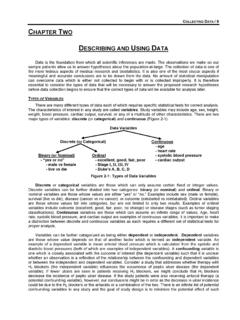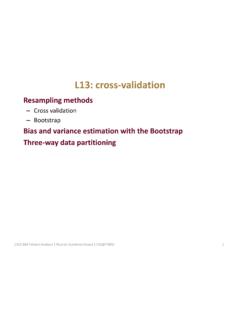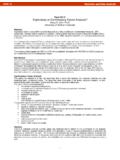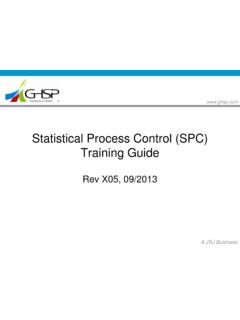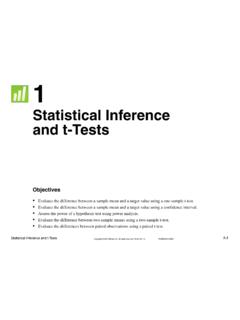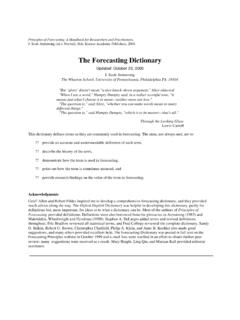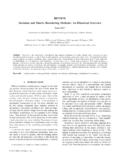Transcription of Best practices in exploratory factor analysis: four ...
1 A peer-reviewed electronic journal. Copyright is retained by the first or sole author, who grants right of first publication to the Practical Assessment, Research & Evaluation. Permission is granted to distribute this article for nonprofit, educational purposes if it is copied in its entirety and the journal is credited. Volume 10 Number 7, July 2005 ISSN 1531-7714. Best practices in exploratory factor analysis : Four Recommendations for Getting the Most From Your analysis Anna B. Costello and Jason W. Osborne North Carolina State University exploratory factor analysis (EFA) is a complex, multi-step process. The goal of this paper is to collect, in one article, information that will allow researchers and practitioners to understand the various choices available through popular software packages, and to make decisions about best practices in exploratory factor analysis .
2 In particular, this paper provides practical information on making decisions regarding (a) extraction, (b) rotation, (c). the number of factors to interpret, and (d) sample size. exploratory factor analysis (EFA) is a widely EFA is a complex procedure with few absolute utilized and broadly applied statistical technique in the guidelines and many options. In some cases, options social sciences. In recently published studies, EFA vary in terminology across software packages, and in was used for a variety of applications, including many cases particular options are not well defined. developing an instrument for the evaluation of school Furthermore, study design, data properties, and the principals (Lovett, Zeiss, & Heinemann, 2002), questions to be answered all have a bearing on which assessing the motivation of Puerto Rican high school procedures will yield the maximum benefit.
3 Students (Morris, 2001), and determining what types The goal of this paper is to discuss common of services should be offered to college students practice in studies using exploratory factor analysis , (Majors & Sedlacek, 2001). and provide practical information on best practices in A survey of a recent two-year period in the use of EFA. In particular we discuss four issues: PsycINFO yielded over 1700 studies that used some 1) component vs. factor extraction, 2) number of form of EFA. Well over half listed principal factors to retain for rotation, 3) orthogonal vs. components analysis with varimax rotation as the oblique rotation, and 4) adequate sample size. method used for data analysis , and of those BEST PRACTICE. researchers who report their criteria for deciding the number of factors to be retained for rotation, a Extraction: Principal Components vs. factor majority use the Kaiser criterion (all factors with analysis eigenvalues greater than one).
4 While this represents the norm in the literature (and often the defaults in PCA (principal components analysis ) is the default popular statistical software packages), it will not method of extraction in many popular statistical always yield the best results for a particular data set. software packages, including SPSS and SAS, which likely contributes to its popularity. However, PCA is Practical Assessment Research & Evaluation, Vol 10, No 7 2. Costello & Osborne, exploratory factor analysis not a true method of factor analysis and there is relative strengths and weaknesses of these techniques disagreement among statistical theorists about when is scarce, often only available in obscure references. it should be used, if at all. Some argue for severely To complicate matters further, there does not even restricted use of components analysis in favor of a seem to be an exact name for several of the methods.
5 True factor analysis method (Bentler & Kano, 1990; it is often hard to figure out which method a textbook Floyd & Widaman, 1995; Ford, MacCallum & Tait, or journal article author is describing, and whether or 1986; Gorsuch, 1990; Loehlin, 1990; MacCallum & not it is actually available in the software package the Tucker, 1991; Mulaik, 1990; Snook & Gorsuch, 1989; researcher is using. This probably explains the Widaman, 1990, 1993). Others disagree, and point out popularity of principal components analysis not either that there is almost no difference between only is it the default, but choosing from the factor principal components and factor analysis , or that PCA analysis extraction methods can be completely is preferable (Arrindell & van der Ende, 1985; confusing. Guadagnoli and Velicer, 1988; Schoenmann, 1990;. A recent article by Fabrigar, Wegener, MacCallum Steiger, 1990; Velicer & Jackson, 1990).
6 And Strahan (1999) argued that if data are relatively We suggest that factor analysis is preferable to normally distributed, maximum likelihood is the best principal components analysis . Components analysis choice because it allows for the computation of a is only a data reduction method. It became common wide range of indexes of the goodness of fit of the decades ago when computers were slow and model [and] permits statistical significance testing of expensive to use; it was a quicker, cheaper alternative factor loadings and correlations among factors and to factor analysis (Gorsuch, 1990). It is computed the computation of confidence intervals. (p. 277). If without regard to any underlying structure caused by the assumption of multivariate normality is severely latent variables; components are calculated using all of violated they recommend one of the principal factor the variance of the manifest variables, and all of that methods; in SPSS this procedure is called "principal variance appears in the solution (Ford et al.)
7 , 1986). axis factors" (Fabrigar et al., 1999). Other authors However, researchers rarely collect and analyze data have argued that in specialized cases, or for particular without an a priori idea about how the variables are applications, other extraction techniques ( , alpha related (Floyd & Widaman, 1995). The aim of factor extraction) are most appropriate, but the evidence of analysis is to reveal any latent variables that cause the advantage is slim. In general, ML or PAF will give manifest variables to covary. During factor extraction you the best results, depending on whether your data the shared variance of a variable is partitioned from are generally normally-distributed or significantly non- its unique variance and error variance to reveal the normal, respectively. underlying factor structure; only shared variance appears in the solution. Principal components analysis Number of Factors Retained does not discriminate between shared and unique After extraction the researcher must decide how variance.
8 When the factors are uncorrelated and many factors to retain for rotation. Both communalities are moderate it can produce inflated overextraction and underextraction of factors retained values of variance accounted for by the components for rotation can have deleterious effects on the (Gorsuch, 1997; McArdle, 1990). Since factor analysis results. The default in most statistical software only analyzes shared variance, factor analysis should packages is to retain all factors with eigenvalues yield the same solution (all other things being equal) greater than is broad consensus in the while also avoiding the inflation of estimates of literature that this is among the least accurate methods for variance accounted for. selecting the number of factors to retain (Velicer &. Jackson, 1990). In monte carlo analyses we performed Choosing a factor Extraction Method to test this assertion, 36% of our samples retained too There are several factor analysis extraction many factors using this criterion.
9 Alternate tests for methods to choose from. SPSS has six (in addition to factor retention include the scree test, Velicer's MAP. PCA; SAS and other packages have similar options): criteria, and parallel analysis (Velicer & Jackson, unweighted least squares, generalized least squares, 1990). Unfortunately the latter two methods, although maximum likelihood, principal axis factoring, alpha accurate and easy to use, are not available in the most factoring, and image factoring. Information on the frequently used statistical software and must be Practical Assessment Research & Evaluation, Vol 10, No 7 3. Costello & Osborne, exploratory factor analysis calculated by hand. Therefore the best choice for Rotation cannot improve the basic aspects of the researchers is the scree test. This method is described analysis , such as the amount of variance extracted and pictured in every textbook discussion of factor from the items.
10 As with extraction method, there are analysis , and can also be found in any statistical a variety of choices. Varimax rotation is by far the reference on the internet, such as StatSoft's electronic most common choice. Varimax, quartimax, and textbook at equamax are commonly available orthogonal methods of rotation; direct oblimin, quartimin, and promax are oblique. Orthogonal rotations produce factors that are The scree test involves examining the graph of the uncorrelated; oblique methods allow the factors to eigenvalues (available via every software package) and correlate. Conventional wisdom advises researchers looking for the natural bend or break point in the data to use orthogonal rotation because it produces more where the curve flattens out. The number of easily interpretable results, but this is a flawed datapoints above the break ( , not including the argument.)
